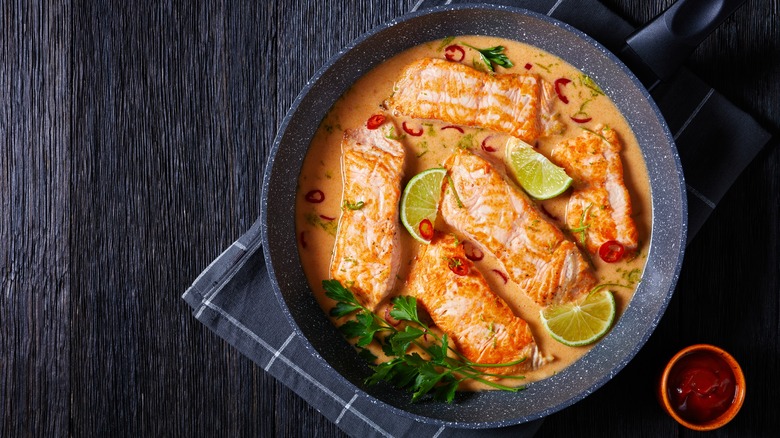For Perfectly Poached Salmon, Make Sure You Score The Skin
Poaching is often associated with making eggs for brunch, but the process can apply to many other foods. In addition to perfectly poached eggs, fish also lend themselves well to this technique because the protein is so delicate. Salmon is among the best meat to poach, and placing it in a broth is a simple way to add moisture. For this method, however, ensure you take all the steps to obtain the best outcome.
When poaching fish, you may notice that they tend to curl up in the liquid. The best way to counteract this is to score the skin before placing it in the poaching liquid. Simply make several shallow cuts in the fish skin with a knife so the tissue doesn't start to curl. This reaction can happen any time salmon is exposed to heat. Scoring will stop the curling process and make for a more professional-looking meal. By adhering to only a few simple steps, you can cook like a restaurant professional, too.
The process of poaching
Poaching is a preferred method for cooking many delicate foods. The cooking method is healthy because it does not require lubricants such as cooking oil. Using low heat, food cooks slowly so it doesn't dry out. This method is particularly useful for salmon, a dish at its best when moist and flaky. As opposed to boiling protein at high temperatures, which typically amounts to your food coming out rubbery, the low heat allows the proteins to cook gradually, leading to a much more tender texture.
For salmon, the most significant part of this process is the poaching liquid. Though you can poach food in practically any base, the most common type is a composition of vinegar and white wine for some acid. Acidity is vital because it helps keep the flaky tissue of the salmon together. Aromatics are also always a welcome addition to the concoction. The fish itself does not need to be seasoned because all the seasonings are in the liquid. Put your poaching base on the heat, but make sure it doesn't exceed 140 degrees Fahrenheit. Allowing the liquid to boil will ruin the poaching technique, and you will not achieve the desired texture. Texture is what salmon is all about, and it is elevated by this method.
What to do with the skin
As with most cooking methods for salmon, its skin separates your dish from mediocre to potentially something great. The skin is a great source of fat, keeping the dish moist and succulent. It is equally important when poaching salmon because it keeps the structure of the fish. Scoring the skin is the secret touch that will put the whole dish together. But unlike the crispness the skin gets when pan-searing, poaching salmon with the skin will culminate in a different texture.
Once you take the fish out of the poaching liquid, be prepared for a less-than-appetizing skin attached. Because the cooking method is low and slow, as well as submerged in water, there will be no aesthetically pleasing crust or satisfying crunch to the flesh of the salmon. Poaching will transform the skin into a slick and often slimy film on the bottom of the fish. So, when you are ready to present the final dish, remove the skin. Scoring the skin means the fish won't curl in on itself, but leaving it on will detract from all your hard work. Even adamant lovers of salmon skin would have to admit that gummy skin is best left by the wayside when it comes to poaching.


